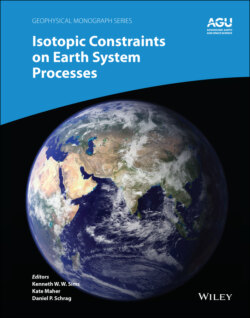Читать книгу Isotopic Constraints on Earth System Processes - Группа авторов - Страница 70
3.2.2. Igneous Samples Characterized for Calcium Isotope Composition
ОглавлениеFour Central American arc basalts were selected for this study. The recent volcanism along the Central American volcanic arc results from subduction of the Cocos Plate beneath the Caribbean Plate (Fig. 3.1) and consists of two regions of magmatism, the volcanic front and back‐arc volcanism (Carr et al., 1990). Three of the studied arc samples come from the volcanic front and one is from a back‐arc volcano. From north to south the samples include: Atitlan volcano, Guatemala (AT‐50), back‐arc Yohoa volcano, Honduras (YO1), San Cristobal volcano, Nicaragua (SC2), and Telica volcano, Nicaragua (TE1). Trace elements ratios (e.g., Ba/La, Ba/Th, Sr/Nb, U/Th) measured in bulk samples and in olivine‐bearing melt inclusions for these samples exhibit a significant amount of the geochemical variation seen both locally and regionally along the volcanic arc that is thought to reflect the influence of subducted sediments (Fig. 3.2; Patino et al., 2000; Sadofsky et al. 2008). Characterization of sedimentary core sampled off the coast at Deep Sea Drilling Program Site 495 indicates early carbonate deposition followed by later hemipelagic deposition involving large differences in incompatible elements and element ratios (e.g., Ba/Th). These differences can be used to identify sediment contribution and even possibly to distinguish between carbonate deposition and hemipelagic deposition (see Fig. 3.2). In particular, the carbonate sediments are believed to provide a distinctive geochemical signature that has been used to track the flux of sedimentary addition to the arc magmas (Patino et al., 2000). Bulk powders of the samples were obtained from M. Carr. Their major, trace element, and isotopic compositions have been reported by Bolge et al. (2009), Carr et al. (1990), Feigenson (1986), Leeman et al. (1994), and Patino et al. (1997; 2000), see electronic supplement.
Table 3.2 Difference between igneous rocks used to estimate δ44Ca of BSE and SRM915a standard for various research laboratories.
| Lab Facilities | Method | 44Ca/40CaBSE‐SRM915a | 2σ | Source |
|---|---|---|---|---|
| Center for Isotope Geochemistry, University of California at Berkeley | DS‐TIMS | 0.97 | 0.07 | Simon & DePaolo (2010); this work |
| Center for Isotope Cosmochemistry & Geochronology, NASA Johnson Space Center | DS‐TIMS | 0.96 | 0.04 | Simon et al. (2017) |
| Isotope Research Geo‐ and Cosmochemistry Group, Harvard University | DS‐TIMS | 0.97 | 0.04 | Huang et al. (2011) |
| State Key Laboratory of Isotope Geochemistry, Guangzhouz Institute of Geochemistry, Chinese Academy of Sciences | DS‐TIMS | 0.94 | 0.04 | Kang et al. (2017) |
| Institut für Mineralogie, WWU Münster* | DS‐TIMS | 0.91 | 0.03 | Bermingham et al. (2018) |
| IFM‐GEOMAR Leibniz‐Institut fur Meereswissenschaften, Keil, Germany & University of Saskatchewan Isotope Laboratory, Department of Geological Sciences, University of Saskatchewan, Canada | DS‐TIMS | 0.93 | 0.17 | Amini et al. (2009) |
| Institut de Physique du Globe de Paris | MC‐ICP‐MS | 0.90 | 0.08 | Valdes et al. (2014) |
| Institut de Physique du Globe de Paris | MC‐ICP‐MS | 1.00 | 0.10 | Amsellem et al. (2019, 2020) |
| Princeton University** | MC‐ICP‐MS | 0.99 | 0.14 | Blattler & Higgins (2017) |
| Arizona State University** | DS‐MC‐ICP‐MS | 0.85 | 0.16 | Ionov et al. (2019) |
| State Key Laboratory of Geological Processes and Mineral Resources, China University of Geosciences, Wuhan** | MC‐ICP‐MS | 1.03 | 0.14 | Chen et al. (2018, 2019a,b) |
Note: ∆44 Ca/40CaBSE‐SRM915a = δ44Ca/40CaBSE ‐ δ44Ca/40CaSRM915a
MC‐ICP‐MS methods obtain δ44 Ca/40Ca by multiplying δ44Ca/42Ca by a scaling factor. If not stated standard errors are estimated by multiplying those reported by 2.049.
* Value estimated by comparison of reported δ44Ca/40Ca of BHVO‐2 to that of Huang et al. (2011).
** Value estimated by comparison of reported δ44Ca/40Ca of SRM915b to that of Simon et al. (2017).
Figure 3.1 Maps of Central America, Eastern Africa, and Europe showing location of the studied samples. The location of the DSDP Site 495, off the coast of Guatemala, is also indicated
(Central American map modified from Patino et al., 2000).
Two fresh carbonatite lavas, collected immediately after eruptions in 2007 and 2008 from Oldoinyo Lengai volcano, Tanzania, were also selected for this study. Oldoinyo Lengai is located on the eastern branch of the East African Rift Valley and is the only modern extrusive carbonatite locality (Fig. 3.1). The sample from 2007 (OL lava 2007) is representative of the large volumes of rare, relatively Na‐rich (natro‐) carbonatite lavas extruded until August 2007. The younger lava (OL lava 4‐7‐08) was extruded at a time when Oldoinyo Lengai was erupting more silicic ashes (Fischer et al., 2009). Both samples were provided to me by T. Fisher.
The final sample was a clast of intrusive carbonatite from the Laacher See volcano, Germany. Laacher See volcano is located in the Late Pleistocene East Eifel Volcanic Field that is part of a series of intra‐plate volcanic fields in Central Europe (Fig. 3.1). The carbonatitic ejecta clast was extruded ~12.9 ka as part of the most recent episode of highly alkalic and silica‐undersaturated magmas (Schmitt et al., 2010; references therein). The material analyzed comes from a rounded nearly 100% sövite domain (~cm in size) associated with coarse‐grained calcite. The sample was provided by A. Schmitt who conducted an accessory mineral uranium‐series dating study to address the magmatic longevity of the most recent period of subvolcanic magmatism (Schmitt et al., 2010).
Figure 3.2 Regional variations in trace element ratios along the Central American volcanic arc. MORB‐like Ba/La and Ba/Th values occur in Honduras volcanoes whereas maximum values, believed to be tracers of hemipelagic sediment and marine carbonate, respectively, occur in western Nicaraguan volcanoes
(data from Patino et al., 1997, 2000).
